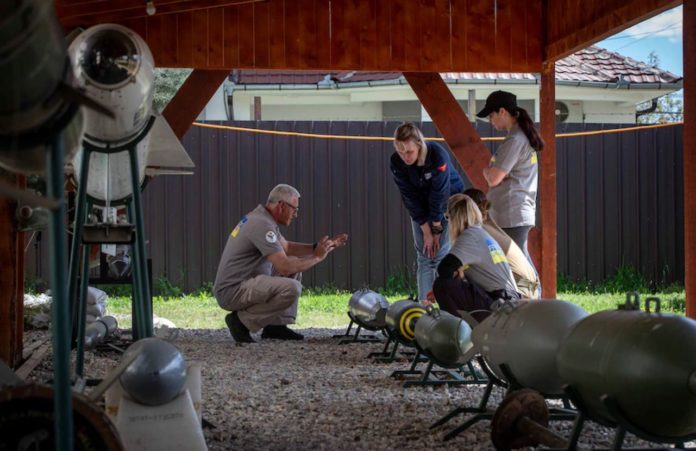Dangerous mines and duds will remain in the ground when the conflict in their homeland is done. That is why Ukrainian women are being trained in mine removal in Kosovo.
Anastasiia Minchukova could never have guessed that she would one day learn how to locate and defuse landmines. The Ukrainian had completely different topics on her mind and on her daily job schedule as an aspiring English instructor. However, there is now war. Minchukova is standing in a field in Kosovo, getting trained in mine detecting, rather than being at university and in the classroom.
Former battle zones are teeming with wisdom
“There is a huge demand [for] people who know how to do de-mining because the war will be over soon,” says the young woman.
She expects that the battle in her homeland will be over soon, and those deadly explosive devices will be hidden in the ground in numerous areas, requiring immediate removal.
“We believe there is so much work to be done,” explains the 20-year-old.
Minchukova stands with five other Ukrainian women in a field littered with warning signs on the outskirts of Peja, Kosovo, wearing protective gear and holding a mine detector. The women learn everything they need to know about hunting for and defusing explosive legacies over an 18-day course.
Course in Kosovo
Thousands of unexploded mines were left in the ground and rubble after the Kosovo conflict in the late 1990s. Praedium Consulting Malta, a Maltese company that specializes in explosive ordnance disposal, offers training courses in this context. Instructor Artur Tigani designed the present course schedule to mirror the local conditions as closely as feasible for future explosive device searches in Ukraine.
Tigani, a former engineer in the Yugoslav armed forces, says he’s ready to share his knowledge. Even though the Kosovo war ended 23 years ago, the memories of it – and the hardships he and his colleagues faced when they first started with explosive ordnance removal – are still fresh.
“Relics” of the war
It’s impossible to say how many explosives and duds will be strewn across Ukraine after the war. However, previous conflict experience implies that there is a major issue. The International Red Cross confirmed at a UN summit in December that explosive residues of war continued to kill and maim thousands of people long after the combat had finished in many parts of the world. The majority of those killed are children.
Global issue
The Red Cross cautions that locating explosive devices in the rubble and searching for them among everyday objects that sometimes look identical is a “dangerous, onerous and often extremely time-consuming task.” At the end of last year, 56 countries were polluted with unexploded ordnance, according to data from the Norwegian NGO Mine Action Review. Afghanistan, Cambodia, and Iraq were the countries most affected, followed by Angola, Bosnia and Herzegovina, Thailand, Turkey, and Yemen.
Russian troops are believed to have deployed both anti-personnel and anti-vehicle mines in their campaign in Ukraine, according to military specialists. Ukraine, on the other side, is likely to have used anti-tank mines to halt the assailants’ advance.
Service to the next generation
Yuliia Katelik is being taught in mine detecting alongside Anastasiia Minchukova. When her children return home, the 38-year-old believes it should be safe for them. She fled to Poland with her three children at the start of the war, then returned to Ukraine to help defend the country from the invaders. Yuliia Katelik is from Kramatorsk, a city in eastern Ukraine where a rocket strike on a train station killed more than 50 people and injured scores more than three weeks ago.
Her only wish, she added, was to witness “the end of this nightmare” and rejoin with her family.
And then she wants to be able to recognize booby traps and render them harmless so that her life is not destroyed again.
Meanwhile, the training center in Kosovo does not only want to train Ukrainian women in Peja.
“We’re planning as well to go to Ukraine very soon and start with delivery of courses there,” announces Tigani, “on the theatre of war.”
Image Credit: Getty
You were reading: Ukrainian women learn how to defuse mines to make home safe for return
